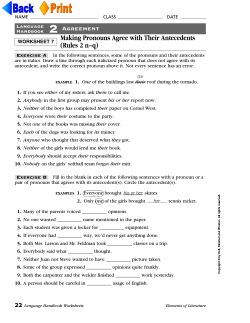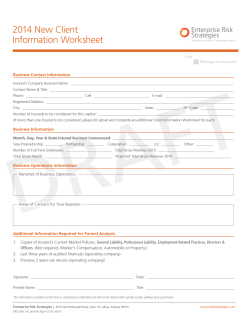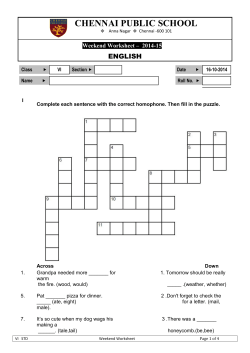
114 DEVELOPMENT OF STUDENTS WORKSHEET BASED ON
Unesa Journal of Chemical Education Vol 3, No 1, pp.114-118, Januari 2014 ISSN: 2252-9454 DEVELOPMENT OF STUDENTS WORKSHEET BASED ON METACOGNITIVE STRATEGY ON STOICHIOMETRY MATTER FOR X GRADE SENIOR HIGH SCHOOL STUDENTS Fitria Dwi Lestari and Rusly Hidayah Chemical Education, Faculty of Math and Sciences University State of Surabaya, Jl. Ketintang, Surabaya e-mail: piet_cwiit@yahoo.co.id Abstrak Tujuan penelitian ini adalah untuk mengembangkan LKS berbasis strategi belajar metakognitif pada kategori metacomprehension pada materi perhitungan kimia dan mendeskripsikan kelayakan LKS, serta untuk mengetahui respon siswa terhadap LKS yang dikembangkan. Metode penelitian yang digunakan adalah model 4-D tetapi hanya tiga tahap yang dilakukan pada pengembangan ini (3-D models), yaitu define, design, develop. Sasaran penelitian ini yaitu lembar kerja siswa berbasis strategi belajar metakognitif terutama kategori metacomprehension pada materi perhitungan kimia. Uji coba LKS secara terbatas di SMA Negeri 2 Lamongan pada 20 siswa kelas XI. Hasil penelitian menunjukkan bahwa kelayakan LKS mendapat rata-rata skor validasi untuk tiap aspek, meliputi aspek komponen LKS, penyajian LKS, isi LKS, kesesuaian dengan komponen bahasa dan kesesuaian dengan kriteria metacomprehension dengan skor berturut-turut sebesar 83,33%, 80%, 86,67%, 85%, 80%, dan 97% dengan kategori kuat. Dan siswa merespon positif terhadap LKS yang dikembangkan dengan skor ≥ 61% untuk tiap aspek, dengan skor tiap aspek berturut-turut sebesar 97%, 92%, 100%, dan 97%.. Kata kunci: lembar kerja siswa berbasis strategi belajar metakognitif, metacomprehension, perhitungan kimia Abstract The aims of this research were to develop student’s worksheet based on metacognitive strategy in metacomprehension category on stoichiometry matter, to describe its feasibility and to know student’s response to the worksheet developed. This research method used 4-D model but only three steps were done (3-models), such as define, design, and develop. This research target was student worksheet based on metacognitive strategy especially in metacomprehension category on stoichiometry matter. The trial of student worksheet was done limited to 20 students in XI grade of SMA Negeri 2 Lamongan. The result showed that student worksheet were developed with feasibility score for each components, such as component aspect of worksheet, presentation of worksheet, content of worksheet, suitability with language component, and suitability with metacomprehension criterion with the score continuously are 83.33%, 80%, 86.67%, 85%, 80% and 97% which categorized as good. And students responded positively to the worksheet with score is ≥ 61% for each aspect, with the score for each aspect continuously are 97%, 92%, 100%, and 97%. Key words: student worksheet based on metacognitive strategy, metacomprehension, stoichiometry INTRODUCTION The quality of education in Indonesia is quite low. Based on data from the Education for All (EFA) Global Monitoring Report, in 2007, ranking of Education Development Index (EDI) of Indonesia dropped from position 58 to 62 from the previous year. As described in the 114 Kompas (31th December 2007:14), this ranking then dropped to rank 65 in 2010. Further data issued by UNESCO, March 1, 2011 in New York , Indonesia was ranked 69 of 127 countries in the world. The decline of Indonesia 's achievement has been the concern of many educators. The government has organized the improvements improve the Unesa Journal of Chemical Education Vol 3, No 1, pp.114-118, Januari 2014 ISSN: 2252-9454 quality of education in order to achieve national education goals. However, the facts have not shown satisfactory results . In the fact a lot of the problems faced in the educational world in Indonesia. One is the weakness in the learning process. The process of teaching and learning that is not running optimally because the teacher would only seek to teach all the material that has been determined in a very limited time interval. Meanwhile, students also will be forced to accept any materials without having much time to depth. So that students mostly only able to memorize the material and is very difficult to answer the questions that require an understanding descriptions. Students' lack of understanding is also because students do not have the awareness of how they learned. If students are able to understand how they learned or known by the term metacognition can bet students will acquire knowledge more meaningful. Some research on metacognitive focus on three categories, namely 1. Metamemory; 2. Metacomprehension, and 3. Self-regulation. However, this study only focuses on metacomprehesion categories, that is the ability of learners to determine the level of their understanding of the information obtained, knowing the error, and choosing a more effective strategy to correct the problem [1]. The problem that arises from the interview with chemistry teacher in SMA Negeri 2 Lamongan, known to the average student in the school lacks confidence in them. They tend to be easier to understand the concept when asked a friend or as guided by the teacher, so that they can assess their own abilities. Thus concluded that the ability bias metacomprehension they are still low. In addition, during this outstanding students’ worksheet, there is no worksheet that can help students to learn metacognitive strategies especially for metacomprehension category. Solutions in addressing the issue raised by implementing strategies metacomprehension through worksheets. Due to this strategy, students will be trained 115 to monitor the results of the development of his own that he was directly involved in the learning process. In addition, it is also expected to be one of the efforts to facilitate the students understand the concept. Students will know that the information has been obtained, reflect, and evaluate the results of his own ideas to the problems given. Based on these problems, the aim of this research is to develop and generate worksheets based on metacognitive learning strategies are feasible to use on stoichiometry matter. METHODS For the development of teaching materials used 4-D Model (Four D Model) [3]. This study was limited to testing the feasibility, just three stage, such as: design, define, and develop are done and the fourth stage, disseminate is not done. The data of this study was obtained from the interview to one chemistry teacher. And validation conducted by two chemistry lecturer and one chemistry teacher. Limited testing conducted on 20 students in class XI Science of SMAN 2 Lamongan because the school curriculum implemented changes, so the limiting trial was change from X class to XI class. The results of the validation are analyzed quantitatively. Eligibility criteria assessed by the following table [4] Table 1. Likert Scale Criteria Score Very Good 5 Good 4 Enough 3 Bad 2 Very Bad 1 Formula that used for get percentage like shown below: P(%)= x100% Based on the percentage that have been calculated, then the eligibility criteria can be determined by the following table [4]. Table 2. Score Interpretation Criteria Percentage Criteria 0% - 20 % Very poor Unesa Journal of Chemical Education Vol 3, No 1, pp.114-118, Januari 2014 Continuou of Table Interpretation Criteria 2. ISSN: 2252-9454 Score 21 % - 40 % Poor 41 % - 60 % Enough 61 % - 80 % Good 81 % - 100 % Very good Development of worksheet based on metacognitive strategy is categorized as good/proper if percentage of every criteria is ≥61%[4].Students response is gain from questionnaire sheet. Students give score for every criterion by using score in the Table 3. Table 3. Guttman Scale Statement Score Yes 1 No 0 The calculation of the percentage of each criterion using the following equation: K= x100% K= percentage of feasibility Based on the percentages have been calculated, then the eligibility criteria can be determined using Table 2. Table 2. Score Interpretation Criteria Percentage Criteria 0% - 20 % Very poor 21 % - 40 % Poor 41 % - 60 % Enough 61 % - 80 % Good 81 % - 100 % Very good RESULTS AND DISCUSSION Define Stage Preliminary analysis Some things to consider at the beginning of the analysis are as follows: (1) the curriculum used at SMAN 2 Lamongan is KTSP curriculum. (2) Standards competence and basic competences in stoichiometry matter. Standards competence: Understanding the basic laws of chemistry and its application in stoichiometry [2]. Basic competences: Proving and communicate enactment of basic laws of chemistry through experiments and apply 116 the mole concept in solving chemical calculations [2]. Students Analysis Characteristics of students in SMAN 2 Lamongan are (1) students have acquired stoichiometry matter. (2) Students of XI IPA 1 SMAN 2 Lamongan average age was 1618 years. (3) Students of XI IPA 1 SMAN 2 Lamongan at the time of the study had received the stoichiometry matter from the teacher, but do not use the Student Worksheet based on metacognitive learning strategies. Concept Analysis The analysis is done by identifying the concept of how the concept of stoichiometry topic and arranged systematically. The result of our analysis is the concept maps of stoichiometry topic. Design Stage At this stage the activities carried out by the researchers is to design and format of the Student Worksheet based on metacognitive learning strategies, then consultation with the chemistry lecturer before tested to the students. Preliminary Design This stage aims to design Student Worksheet based on metacognitive learning strategies. The main activity at this stage is writing the Student Worksheet and consultation to the lecturer. Worksheet components consist of the title; title page; way the use of worksheets; summary of the material; initial page of worksheet; contents of worksheet; stages of completion; piercings of worksheet; and bibliography. Develop Stage Review and revision I Review of worksheet based on metacognitive strategies conducted by lecturers and chemistry teacher. Activities undertaken are asking for input from the Unesa Journal of Chemical Education Vol 3, No 1, pp.114-118, Januari 2014 ISSN: 2252-9454 lecturer and teachers of chemistry to one draft worksheets that have been made in order to obtain results in the form of draft II. Chemistry lecturer and teacher give suggestion on the suitability of the content, presentation, graphic, appropriateness of the language used and the design of the display, fonts, illustrations, image, and quality of the questions given in the worksheet. Validation/ Feasibility Validation is done by two lecturers and one teacher who assess the aspects in the worksheet, such as: (1) component of worksheet, (2) presentation of worksheet, (3) content of worksheet, (4) illustration of worksheet, (5) suitability with language component, and (6) metacomprehension criterion. Assessment is done by using validation sheet. The validation result can be shown in the Figure 1 below. Next, to know students response is done by filling of students’ response sheet (questioner). The result of questioner is analyzed descriptive quantitatively to know how many students that answer “Yes” in every aspect. Quantitative result by looking at the percentage of students who answer “Yes” in every aspect. Result of students’ response of worksheet that developed can be shown in Figure 2 below. Figure 2. Students Response to the worksheet based on metacognitive strategies Based on figure 2 is gain that all of the aspect of worksheet get positive response from the students because get percentage is ≥ 61% [3]. The score for each aspect continuously are 97%, 92%, 100%, and 97%. Figure 1. Validation result of worksheet based on metacognitive strategy Based on figure above, percentage result of worksheet feasibility for each component get score is ≥61% which categorized good with the score for each component continuously are 83.33%, 80%, 86.67%, 85%, 80% and also 97%. Limited Trial Limited testing to determine students' responses after using worksheets developed. Worksheet tested on 20 students XI IPA 1 in SMAN 2 Lamongan. Students Response 117 CONCLUSION Based on the research that has been done, we can conclude that: 1. Feasibility of worksheet from components of worksheet, presentation of worksheet, content of worksheet, suitability with language component, and with metacomprehension criterion is categorized as proper/good with feasibility percentage of each components is ≥ 61% which categorized good with the score for each worksheet component continuously are 83.33%, 80%, 86.67%, 85%, 80% and 97%. 2. Students’ response to the worksheet is positive with percentage is ≥ 61% with the score for each aspect continuously are 97%, 92%, 100%, and 97%. Unesa Journal of Chemical Education Vol 3, No 1, pp.114-118, Januari 2014 ISSN: 2252-9454 ACKNOWLEDGMENTS We gratefully acknowledge the Lembaga Penelitian dan Pengabdian Masyarakat (LPPM) University State of Surabaya, for providing research support through DIPA Penelitian Dana BOPTN Mahasiswa 2013. REFERENCES 1. Martinez, M. 2006. What is Metacognition? Teacher Intutyvely Recognize The Importance of Metacognition But Not Be Aware. 2. Depdiknas. 2006. Kurikulum 2006 Standar Kompetensi Mata Pelajaran. Jakarta: Direktorat Jendral Pendidikan Dasar dan Menengah. 3. Thiagarajan, S., Semmel, D. S & Semmel, M. I. 1974. Instructional Development for Training Teachers of Expectional Children. Minneapolis, Minnesota: Leadership Training Institute/Special Education, University of Minnesota. 4. Riduwan. 2007. Skala-skala Pengukuran Variabel-variabel Penelitian. Bandung: Alfabeta. 5. Nur, Muhammad, Prima Retno Wikandari, Bambang Sugiarto. 1998. Teori Pembelajaran Kognitif. Surabaya: Unesa University Press. 118 6. Anonim. 2013. Metacognition. [Online]. (http://en.wikipedia.org/wiki/Metacogniti on, accessed on 11th February 2013). 7. Corebima, A. D. 2011. Berdayakan Kemampuan Berfikir dan Kemampuan Metakognitif selama Pembelajaran. [Online].(http://harvemoningka.blogspot. com/2011/12/ berdayakan kemampuan-berpikir-dan.html, accessed on 6th February 2013). 8. Depdiknas. 2004. Pedoman Penyusunan Lembar Kegiatan Siswa. Jakarta: Direktorat Jendral Pendidikan Dasar dan Menengah. 9. Shabri, M. Abd. Majid. 2013. Potret Buram Pendidikan Kita. [Online](http://aceh.tribunnews.com/201 3/01/03/potret-buram pendidikan-kita accessed on 6th February 2013). 10. Yasir, Moh. 2013. Pengembangan Lembar Kerja Siswa (LKS) Berbasis Strategi Belajar Metakognitif untuk Meningkatkan Hasil Belajar Siswa pada Materi Pewarisan Sifat Manusia. [Online].(http://ejournal.unesa.ac.id/data/ journals/34/articles/1622/submission/cop yedit/1622-3150-1-CE.pdf accessed on 9th February 2013).
© Copyright 2025










